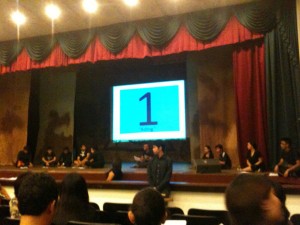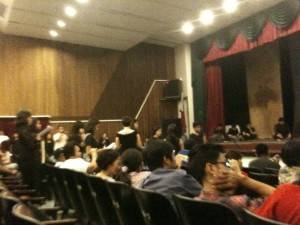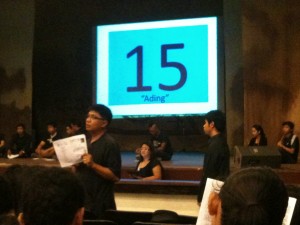
Audience Navigation
Utility Navigation
Student Blogs
20th Century Music-More fun in the Philippines
 Thursday night was a very special occasion. The University of the Philippines College of Music was giving a free concert featuring environmental music (music that reflects man, nature, and how they interact). Lo and behold, two of the composers I was studying had featured performances, including Prof. Ramon Santos and the late Prof. Jose Maceda. It was truly inspiring. This was my first live performance of their music.
Thursday night was a very special occasion. The University of the Philippines College of Music was giving a free concert featuring environmental music (music that reflects man, nature, and how they interact). Lo and behold, two of the composers I was studying had featured performances, including Prof. Ramon Santos and the late Prof. Jose Maceda. It was truly inspiring. This was my first live performance of their music.
The first composition was written as an entirely graphic score (notation through pictures and images rather than standard western notation) made of 4 squares strewn across the score sheet. Quadrasyon, calls for 4 groups of performers aligned in the hall to ‘read’ the graphics of their squares. While there is no music in the square, it is necessary for the performers to fill the hall.
“The notation is such that it can read from the four sides of the one-page score. While the dynamic range is suggested by the size of each square, the pitches are represented by technical reading of the score, the music is what the performers create in synergy with one another in relation to the space that surrounds them as well as the way they interpret the dots.” -R. Santos
The second work was an avant-garde piece by Prof. Jonas Baes. Patangis-Buwaya (2003), written for 4 wind instruments from any culture and audience has a rudimentary progression through different sounds and events. Many of the sounds are moans of pain to simulate the deaths of innocent Iraya-Mangyan indigenous minorities caught in a crossfire during conflicts of the Southern Philippines. The title roughly translates to “music that could even make the crocodiles weep.” It is a mournful piece that weeps over the anguish of these people that culminates audience with audience participation in a somber ringing of bells and sounding wooden blocks handed out by the stage hands.
The final work was a semi-aleatoric work (performers’ decisions of what to play, how fast, how many times are left up to the performer but music is provided) by the late, great, Jose Maceda. Ading (1978) was written for 100 instrumentalists, 100 singers, and audience. Maceda wanted to simulate the changes of nature in this work. Maceda’s work ethos was inspired largely by his personal observations of the Philippine jungles. He noticed that nature progresses slowly and deliberately. In order to truly encapsulate the natural world through music, one must write compositions in a process based style, forming an evolution toward a destination. One event leads to another. The whole performance was led by one conductor and one powerpoint operator who posted slides with numbers and text that are then relayed to the performances and audience. Performers carried scores that told them when to play certain melodies (primary musical lines). Forming the basement for the piece is a continuous and free ostinato (repeated musical line that often lays a framework for a piece of music) of bamboo instruments including Philippine buzzers, woodblocks, and flutes serenading the hall, playing at different times to add timbral diversity. The piece cycles through 26 different timed events that all seem to flow logically as if a river were flowing carrying the piece. Maceda described his own work:
“In Ading, the musical machinery is composed of instrumentalists with the public providing a continuous sound, and a group of vocalists emitting a discontinuous melody. The music is slow to change. When the melody changes, it requires the cooperation of the entire machinery. Ading‘s economy of musical techniques is like a frugal village economy which is conditioned by the forces of nature and which in turn are communicated to the people through ritual and ceremonies.”
The audience reaction was overwhelming. The hall sounded with applause and many people, myself included, went to greet and thank Dr. Santos and Dr. Baes who were in attendance. Throughout Ading, the whole hall vibrated with the sounds of the chant displayed on the screen.
Now, I know I gave a lot of information and many people probably right now are more than likely scared of this type of music, but this is what’s happening in the Philippines. In a way, these types of pieces explain the Filipino experience. You get a real sense of the literal environment in nature but also the social environment in how each work is performed. My blog is totally ineffective in explaining to readers what the Philippines is like compared to their music. The music transcends Filipino culture through combining concepts of community, ritual, and nature all through music. More importantly, the audience got it. It all made sense to them and they enjoyed it. These are the Philippines’ Aaron Coplands, Philip Glasses, and Leonard Bernsteins. To me it is something special and for anyone who thinks it is a bunch of hogwash (in the words of the great 20th century composer Milton Babbit):
-“I don’t care if you listen.”

Paul Fontelo '13
- Studies: History and music double major
- Hometown: Potomac, Md.
- Alumni
- Read more about Paul »
 Emily Castillo '19
Emily Castillo '19
Former Blogger Gianna DiMaiolo '19
Gianna DiMaiolo '19
Former Blogger Brian Senier '19
Brian Senier '19
Former Blogger Amy Casey '18
Amy Casey '18
Former Blogger Michael DeSantis '18
Michael DeSantis '18
Former Blogger Alexandra Larkin '18
Alexandra Larkin '18
Former Blogger Emily Breakell '17
Emily Breakell '17
Former Blogger Haylie Butler '17
Haylie Butler '17
Former Blogger Ellen Chen '17
Ellen Chen '17
Former Blogger Jessica Vozella '17
Jessica Vozella '17
Former Blogger Caroline Keane '17
Caroline Keane '17
Former Blogger Hildie Hoeschen '17
Hildie Hoeschen '17
Former Blogger Elena Ferguson '17
Elena Ferguson '17
Former Blogger Thomas Vignati '17
Thomas Vignati '17
Former Blogger Holly Nord '16
Holly Nord '16
Former Blogger Ali Olson '17
Ali Olson '17
Former Blogger Jonathan Thompson '17
Jonathan Thompson '17
Former Blogger Bryan Rodriguez '17
Bryan Rodriguez '17
Former Blogger Inez Asante '16
Inez Asante '16
Former Blogger LiAnn Butterfield '16
LiAnn Butterfield '16
Former Blogger Lauren Tilmont '16
Lauren Tilmont '16
Former Blogger Mary Zabinski '13
Mary Zabinski '13
Former Blogger Katharine Shapleigh '13
Katharine Shapleigh '13
Former Blogger Kelsey Horton '13
Kelsey Horton '13
Former Blogger Rosemary Henry '14
Rosemary Henry '14
Former Blogger Kevin Gallagher '13
Kevin Gallagher '13
Former Blogger Vivian Daly '13
Vivian Daly '13
Former Blogger Sarah Rondeau '13
Sarah Rondeau '13
Former Blogger Katie Riley '14
Katie Riley '14
Former Blogger Andrew Retallick '14
Andrew Retallick '14
Former Blogger Connor OBrien '16
Connor OBrien '16
Former Blogger Melissa Nelson '10
Melissa Nelson '10
Former Blogger